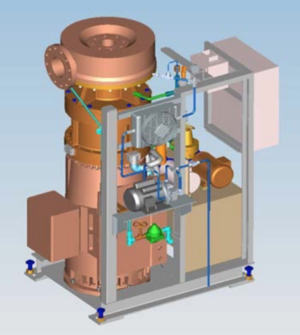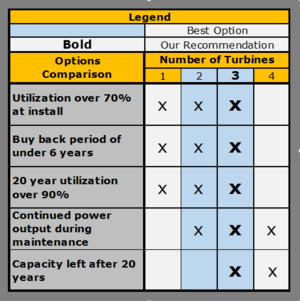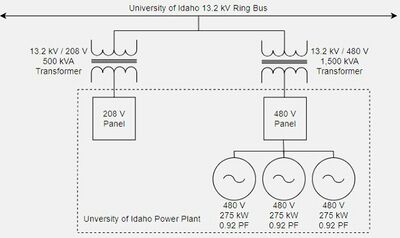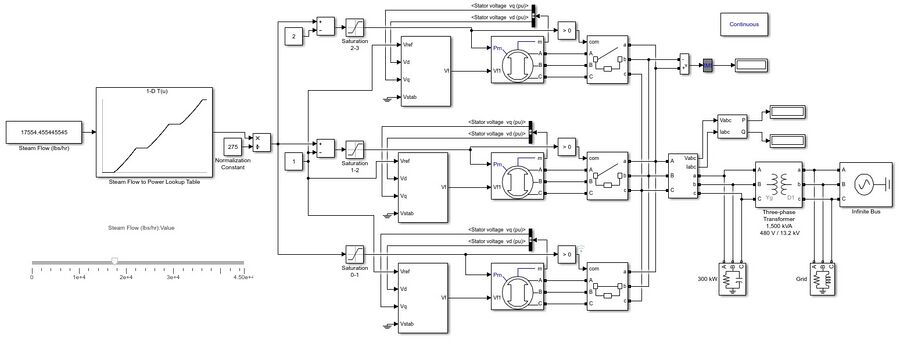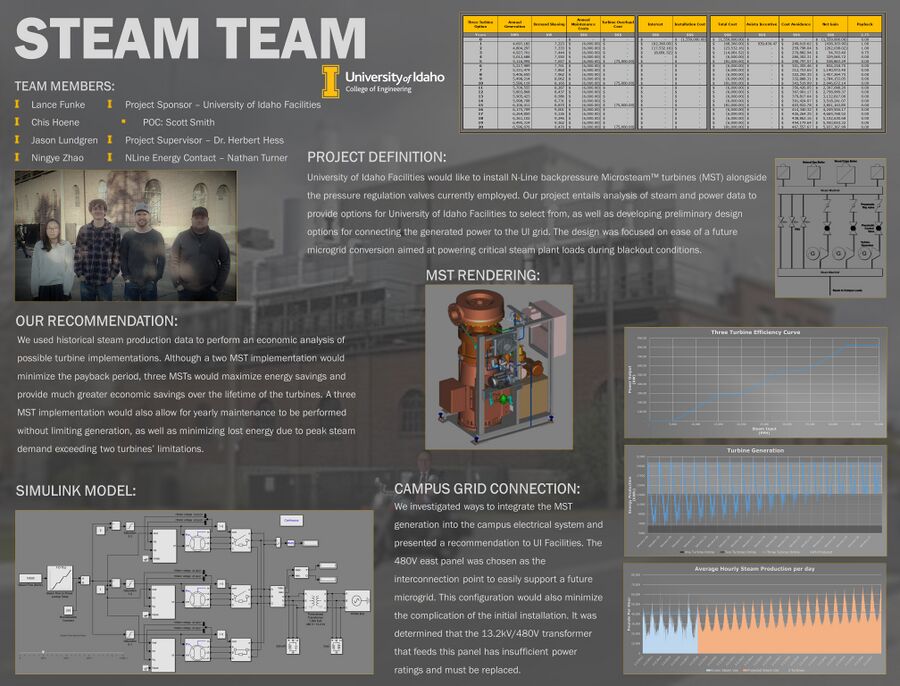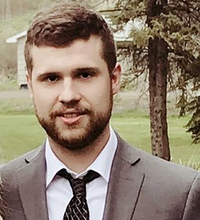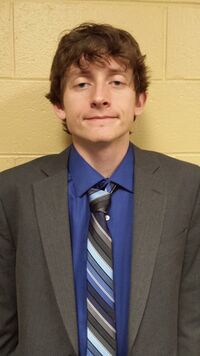UI Steam Turbines
| Turbine Rendering | |
| Team Name | Steam Team |
| Client | Scott Smith |
| Instructor | Dr. Herbert Hess |
| Group Members | Chris Hoene, Lance Funke, Jason Lundgren, Ningye Zhao |
| Duration | Spring 2018 - Fall 2018 |
Summary[edit | edit source]
The goal of this project is to draft a plan for integrating one to three Microsteam(TM) turbines into the University of Idaho steam plant for the purposes of reclaiming energy from backpressure steam produced by the boilers. These turbines will convert waste steam back into electric power which can be used to offset electricity costs to the University, saving money.
Goals[edit | edit source]
Tasks for this project are divided into two phases. In Phase One, multiple turbine packages will be analyzed from an economic standpoint. The two best options will be presented to Facilities. This will be done over the course of the spring semester. Phase Two will begin over the summer and through the fall semester. A more in-depth economic analysis and study of implementation options will be developed during this phase.
Phase One consists of an analysis of the economics of one, two, three, or four turbines installed at the University of Idaho steam plant. The two most optimal turbine packages will be presented to Facilities. An analysis based on historical steam production trends and research of similar projects will be included in this phase. Additionally, preliminary research into grid connection options will be performed towards the end of the semester. At the end of this phase, a presentation of the developed economic analysis and the preliminary electric grid integration options will be given to Facilities.
Phase Two follows University of Idaho Facilities's decision on what turbine package to pursue. It begins with research into integration options for the turbines in the University of Idaho electric grid. Electric consumption of campus buildings and control system options will be considered in the beginning portion of Phase Two. A much more in-depth economic analysis of the chosen turbine package and its implementation options will be performed. By the end of the semester, a well-modeled grid implementation option, in-depth economic analysis of the turbine package, and confirmation of Avista Utilities rebates will be presented to Facilities.
Background[edit | edit source]
The University of Idaho Steam Plant currently regulates steam pressure through the use of pressure regulation valves (PRVs). The energy in the steam vented through these valves is effectively wasted. To recapture this energy, turbines can be installed in parallel with the PRVs to produce electricity from the vented steam. This power can then be used to help power campus, reducing the university's electric bill and conserving energy.
To find the most viable number of turbines, an economic analysis of the different turbine options offered by NLine must be performed. This takes into account historical steam production, expected future steam production, steam turbine power output and efficiency degradation, turbine cost, installation and maintenance costs, and potential rebates from Avista. Once University of Idaho Facilities makes a decision on the desired turbine package based on the information provided by the economic analysis and other research, work can be started on the second phase of the project.
The second phase consists of a more in-depth economic analysis of the chosen turbine package and development of an integration plan for the turbines into the electrical grid. These parts will require selection of power modeling software, comprehensive electrical usage data from the entire campus, and research in how to tie the turbines into the grid. All mechanical work will be done by NLine.
Specifications[edit | edit source]
To be considered a success, the final project needs to receive University of Idaho Facilities' approval and either initiate or influence installation of turbines on campus. To achieve this approval, the top two turbine installation packages will be presented to Facilities at the end of the first semester; work over the summer and second semester will be a more in-depth analysis of the economics and actual implementation of their chosen package.
In addition to the primary goal of satisfying Facilities on an economic scale, the proposed implementation should also be compatible with a future microgrid project and be able to accommodate future steam production loads out to 20 years.
Turbine Package Options[edit | edit source]
NLine offers turbine packages consisting of one, two, or three Microsteam turbines. The economic analysis looked at the net gain and payback periods of each of these options. Two turbines were found to be strictly superior to one turbine in every area except initial cost, having a shorter payback period and nearly twice as much net gain over 20 years. Three turbines greatly boost output and net savings but extend the payback period. Anything past three turbines gives a very marginal return at today's steam levels.
With two and three turbines as the most logical options, a closer look at the respective packages' power output and energy savings was made.
This chart illustrates the power output of the two and three turbine options. The extra capacity of the three turbine option gives better power output during peak steam production periods than the two turbine option. This results in better total power output as early as the first year for the three turbine option. At the end of the 20 year period, the two turbine option is expected to reach full annual utilization. The three turbine option will be around 90%, similar to the two turbine option at the start of the 20 year period.
While the three turbine option produces more power and returns more money over the 20 year period, the two turbine option has a much lower initial cost, and as a result a lower payback period. Nonetheless, the three turbine option's payback period is still relatively short at 5.57 years.
Phase II[edit | edit source]
Summary[edit | edit source]
UI Facilities chose the recommended three turbine package. As a result, second semester efforts were directed towards a more in-depth analysis of the three turbine option and integration into the UI electrical grid. A model for the electrical generation given steam production was developed in Simulink to more accurately model energy losses and the efficiency curve of the turbines. Demand shaving effects of the turbines given the campus's historical electricity usage was also examined. Finally, a study into the effects of the turbines on the resilience of the steam plant and grid was performed.
One major change from first semester work is the switch from an induction generator to a synchronous generator. NLine is developing synchronous versions of their Microsteam turbines. These would be more ideal for our project, as synchronous generators can better maintain 60Hz frequency on startup and with varying steam load. They are also cheaper and more reliable. The tradeoffs are an inability to start in blackout conditions and more lateral space occupied (the turbines must be aligned horizontal instead of vertical like the induction version). Future microgrid projects, however, could utilize the inertia of the system to keep the generator running while the microgrid switches off from the utility power line.
Confirmation of the Schedule 90 incentive from Avista had a major impact on the economic analysis. The payback period of the three turbine option is drastically reduced. While the in-depth economic analysis of the third semester extended the payback period somewhat (as a result of including more realistic modeling of power generation and interest rate on funds for the project), the inclusion of the Avista incentive results in the final payback period being nearly half that of the period specified at the end of Phase I.
Grid Connection[edit | edit source]
Though microgrid design is out of the scope of this project, compatibility with a future microgrid remains a priority. For a future steam plant capable of islanding itself from the grid, the turbines must be able to connect to critical loads. For this reason, the east transformers were chosen for consideration. Of these, only one transformer meets the 480V the generators produce. However, this generator is rated to only 750 kVA. The turbines produce a total of 825 kW at 0.92 PF. If the steam plant consumed a small amount of power while producing large amounts of steam, the transformer could easily exceed its ratings. To prevent such a scenario from happening, it is necessary to purchase a newer transformer rated to at least 1.5 MVA. A newer transformer designed to accept power in either direction would have the side benefit of being more efficient when the steam plant produces in excess of what it uses.
The above diagram shows the 13.2kV line from the East campus feed tied into the Steam Plant's east transformers. It also demonstrates how the generators would tie into the 480V transformer on the plant's side. In a future microgrid project, a breaker (not shown) could be installed just before the 13.2 kV line branches off to the two transformers. This way, under blackout conditions, the generators can still power the 208V loads, replacing the diesel generator that currently serves as backup power to the critical loads on the 208V panel.
Modeling[edit | edit source]
Given the parameters of turbine and generator, a model was developed in Simulink. The model, given a value for steam production, outputs a value for the power production of the three turbines. Available parameters were for the induction generator, as opposed to the synchronous generator that is planned to be produced; however, the production curves and losses are predicted to be very similar.
The above graph represents the efficiency curve for the three turbine system. Best efficiency is obtained by maximizing the utilization of one turbine before distributing steam to another. This efficiency curve is used with our projections of steam production to more accurately model future power production.
Demand Shaving[edit | edit source]
Using this data alongside the past two years' electricity usage by the campus, the potential savings from demand shaving were studied. This study showed that installation of the turbines did not reduce the electricity consumption from Avista below any billing thresholds. As a result, no extra savings from peak shaving were realized.
Updated Economic Analysis[edit | edit source]
With new data from the Simulink model, as well as factoring in the 4% interest rate specified by UI Facilities for private funding, a new economic analysis on the three turbine option was developed. The new calculations set the payback period to 2.75 years; however, this length of time is well within acceptable bounds.
Conclusion[edit | edit source]
In-depth analysis shows the three turbine option to be both viable and desirable to implement in the UI Steam Plant. UI Facilities agreed with this in the first semester, contacting Avista for confirmation of the incentive and reaching out to the financial branch of the University to pursue funding. At the time of this writing, UI Facilities is attempting to secure funding for the project in the hopes of implementation beginning by next year. The project is progressing at such a rate that the desired microgrid will not yet be implemented, just as plans for implementing such a system fell out of this project's scope. However, that topic will be another project for a future group.
Team Information[edit | edit source]
| Picture | Info | Bio |
|---|---|---|
Chris Hoene:
|
Christopher Hoene is an electrical engineering student with an interest in power systems and SCADA. He enjoys design and implementation projects in both academic and leisure settings. Upon graduating he has hopes of pursuing a graduate degree with a focus on power. | |
Lance Funke:
|
Lance Funke is an electrical engineering student with an interest in power and control systems. He is pursuing project management and power engineering, focusing on distribution. After graduation he will continue working in the construction field working on design build and energy projects. | |
Jason Lundgren:
|
Jason Lundgren is an electrical engineering student specializing in power and control systems. He enjoys working on hands-on projects and with controls. Post graduation, he hopes to pursue a career in power. | |
Ningye Zhou:
|
My name is Ningye Zhao and my major is Electrical Engineering. l am interested in the power side of electrical engineering. For this project ,it sparked my interest in energy engineering. l want to continue working on it in the future. Working with my teammates can teach me everything l want to know. |
Documents[edit | edit source]
[Preliminary Economic Analysis]
Presentation Slides[edit | edit source]
[Design Review/Facilities Presentation]
[Facilities Presentation Handout (Scope Inside)]
External Information[edit | edit source]
[University of Montana Case Study]
